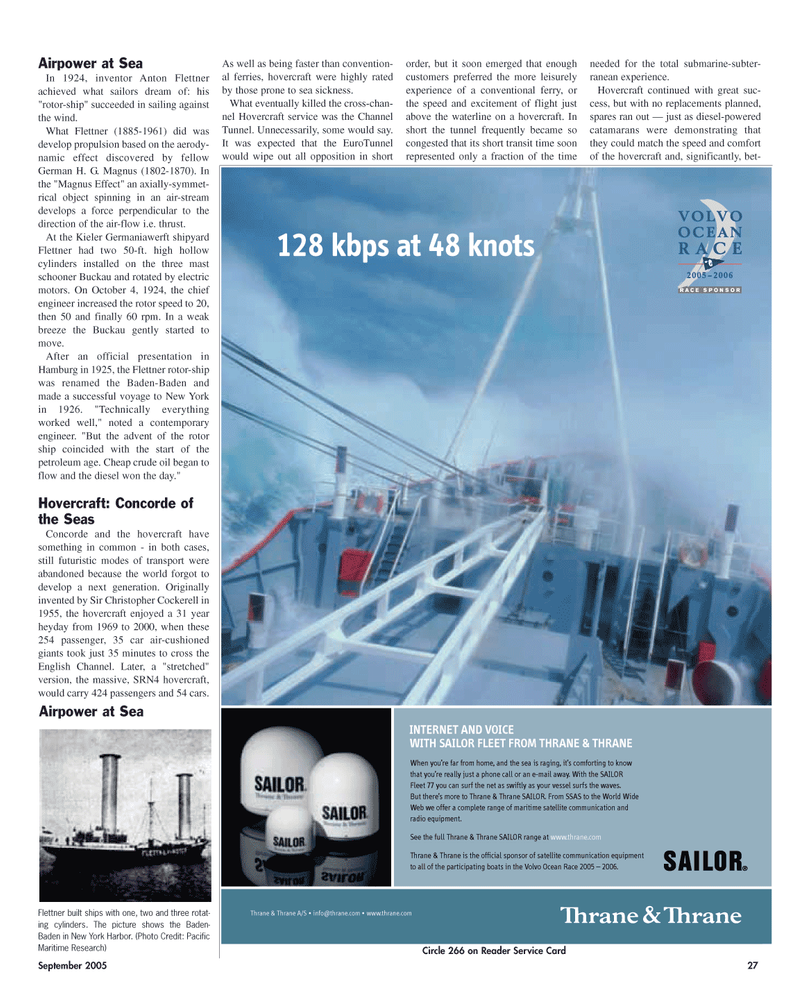
Page 27: of Maritime Reporter Magazine (September 2005)
Marine Propulsion Annual
Read this page in Pdf, Flash or Html5 edition of September 2005 Maritime Reporter Magazine
Airpower at Sea
In 1924, inventor Anton Flettner achieved what sailors dream of: his "rotor-ship" succeeded in sailing against the wind.
What Flettner (1885-1961) did was develop propulsion based on the aerody- namic effect discovered by fellow
German H. G. Magnus (1802-1870). In the "Magnus Effect" an axially-symmet- rical object spinning in an air-stream develops a force perpendicular to the direction of the air-flow i.e. thrust.
At the Kieler Germaniawerft shipyard
Flettner had two 50-ft. high hollow cylinders installed on the three mast schooner Buckau and rotated by electric motors. On October 4, 1924, the chief engineer increased the rotor speed to 20, then 50 and finally 60 rpm. In a weak breeze the Buckau gently started to move.
After an official presentation in
Hamburg in 1925, the Flettner rotor-ship was renamed the Baden-Baden and made a successful voyage to New York in 1926. "Technically everything worked well," noted a contemporary engineer. "But the advent of the rotor ship coincided with the start of the petroleum age. Cheap crude oil began to flow and the diesel won the day."
Hovercraft: Concorde of the Seas
Concorde and the hovercraft have something in common - in both cases, still futuristic modes of transport were abandoned because the world forgot to develop a next generation. Originally invented by Sir Christopher Cockerell in 1955, the hovercraft enjoyed a 31 year heyday from 1969 to 2000, when these 254 passenger, 35 car air-cushioned giants took just 35 minutes to cross the
English Channel. Later, a "stretched" version, the massive, SRN4 hovercraft, would carry 424 passengers and 54 cars.
As well as being faster than convention- al ferries, hovercraft were highly rated by those prone to sea sickness.
What eventually killed the cross-chan- nel Hovercraft service was the Channel
Tunnel. Unnecessarily, some would say.
It was expected that the EuroTunnel would wipe out all opposition in short order, but it soon emerged that enough customers preferred the more leisurely experience of a conventional ferry, or the speed and excitement of flight just above the waterline on a hovercraft. In short the tunnel frequently became so congested that its short transit time soon represented only a fraction of the time needed for the total submarine-subter- ranean experience.
Hovercraft continued with great suc- cess, but with no replacements planned, spares ran out — just as diesel-powered catamarans were demonstrating that they could match the speed and comfort of the hovercraft and, significantly, bet-
When you’re far from home, and the sea is raging, it’s comforting to know that you’re really just a phone call or an e-mail away. With the SAILOR
Fleet 77 you can surf the net as swiftly as your vessel surfs the waves.
But there’s more to Thrane & Thrane SAILOR. From SSAS to the World Wide
Web we offer a complete range of maritime satellite communication and radio equipment.
See the full Thrane & Thrane SAILOR range at www.thrane.com
Thrane & Thrane is the official sponsor of satellite communication equipment to all of the participating boats in the Volvo Ocean Race 2005 – 2006.
Thrane & Thrane A/S • [email protected] • www.thrane.com 128 kbps at 48 knots
INTERNET AND VOICE
WITH SAILOR FLEET FROM THRANE & THRANE
Circle 266 on Reader Service Card
Airpower at Sea
Flettner built ships with one, two and three rotat- ing cylinders. The picture shows the Baden-
Baden in New York Harbor. (Photo Credit: Pacific
Maritime Research)
September 2005 27
MR SEPTEMBER 2005 #4 (25-32).qxd 9/1/2005 12:01 PM Page 27

 26
26

 28
28
